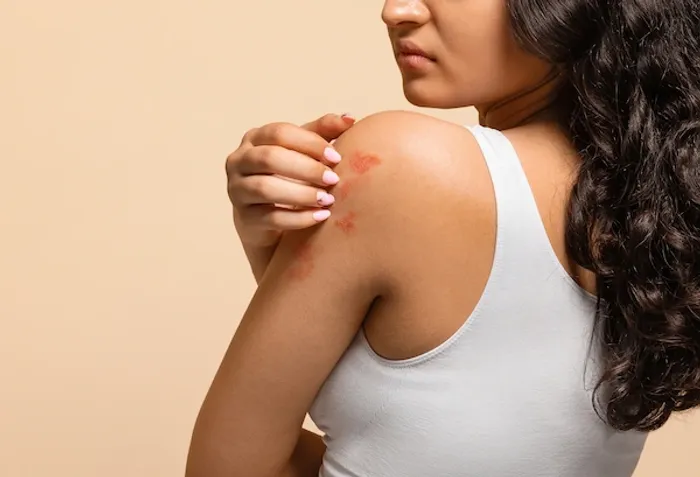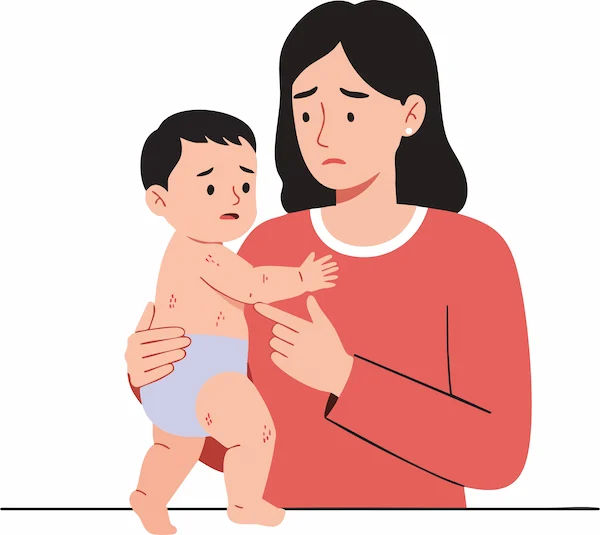Skin Rashes on Body: Causes, Pictures, Treatment
Learn about skin rashes on the body—their causes, types, symptoms, and effective treatments. Discover when to seek medical help and how to manage rashes safely at home.

Written by Dr. M L Ezhilarasan
Reviewed by Dr. Dhankecha Mayank Dineshbhai MBBS
Last updated on 26th Oct, 2025

Introduction
A skin rash on the body can be alarming—especially when it’s itchy, red, or suddenly spreading. The good news is most rashes are mild and respond well to simple steps at home; the challenge is knowing which rash you’re dealing with and when to seek help. This practical guide explains how to “read” a rash on the body by look, feel, and location; outlines the most common causes (from eczema and contact dermatitis to psoriasis, hives, and infections); and shows you safe, effective treatments that won’t make things worse. You’ll learn clear red flags that signal urgent care, what tests doctors use to confirm the diagnosis, and everyday habits that keep skin calm. Whether you’ve developed an itchy red rash on the body after a new soap, a ring-shaped patch after the gym, or a heat rash on your back and chest, this step‑by‑step approach helps you act with confidence. If symptoms persist beyond two weeks, consult a doctor online with Apollo 24|7 for further evaluation and tailored care.
Understanding Skin Rashes on the Body: Basics and Terms
Not all body rashes behave the same, and a few simple terms can help you narrow the cause quickly.
- What a “rash” is: Any visible change in the skin—colour, texture, or sensation—counts. Clues include redness, swelling, warmth, itch, burning, pain, or tenderness. Dryness and scaling often signal inflammation or barrier damage.
Lesion types clinicians describe:
- Macule: flat colour change (like a freckle).
- Papule: small raised bump.
- Plaque: broad, raised area (often scaly as in psoriasis).
- Vesicle: small fluid-filled blister; pustule has pus.
- Wheal: fleeting, raised, itchy welt (hives).
- Crust, scale, fissure: surface changes often seen in eczema or infection.
Distribution and pattern:
- Symmetric vs. asymmetric: Symmetric rashes (both sides) often imply systemic or allergic/inflammatory processes; asymmetric or localised can suggest contact with an irritant, insect bites, or infection.
- Folds (armpits, groin, under breasts) favour yeast and heat rash; friction and moisture drive these.
- Sun-exposed vs. covered skin points toward photosensitivity vs. contact with clothing or products.
- Borders matter: A sharp, ring-like border with central clearing suggests tinea (ringworm); diffuse edges can fit eczema.
Unique insight: Timing tells a story. New itchy rash within 24–72 hours of a new soap, fragrance, watch band, or laundry detergent often signals contact dermatitis. A rash that comes and goes within hours is more compatible with hives than infection. Photographs taken daily under the same light help you or your clinician spot patterns over time.
Common Causes of Body Rashes by Look and Feel
Here are the causes of skin rashes:
Dry, itchy patches: eczema and contact dermatitis
- Eczema (atopic dermatitis) often presents as dry, itchy, rough patches, commonly in body folds; scratching can lead to thickened skin. Triggers include dry air, harsh cleansers, and stress.
- Emollients and short courses of topical steroids are mainstays.
- Contact dermatitis is either irritant (soaps, solvents, sweat friction) or allergic (nickel in jewellery or watch bands, fragrance, hair dye). Clues: rash where the skin touches the culprit (e.g., under a smartwatch band), with itch, redness, and sometimes blisters. Patch testing can confirm allergens.
- Long-tail terms to note: rash after new soap or detergent; best cream for body rash.
Red, thick plaques with silvery scale: psoriasis
Psoriasis favours elbows, knees, and scalp; plaques are well-demarcated and may itch or burn. Nails can have pitting. While psoriasis is chronic, many topical and light-based treatments can calm flares. Psoriatic arthritis may cause joint pain and stiffness.
Hives (urticaria) and angioedema
Hives are transient, raised, very itchy welts that move around and fade within 24 hours; angioedema causes deeper swelling (lips, eyelids). Triggers include infections, medications, foods, heat/cold, or pressure. Non-sedating antihistamines are first-line; keep a trigger diary.
Infections
- Fungal (tinea corporis): ring-shaped rash on the body with a scaly, advancing border and central clearing; spreads via shared towels, mats, or pets. Topical allylamines (terbinafine) or azoles (clotrimazole) work well for limited disease.
- Bacterial: impetigo causes honey-coloured crusts; cellulitis is a hot, tender, expanding area often with fever—needs medical care and antibiotics.
- Viral: shingles starts with tingling/burning pain followed by a stripe of blisters on one side of the body; antivirals taken early can shorten illness and reduce complications.
Heat and sweat-related rashes
- Heat rash (miliaria) causes small, prickly, itchy bumps in hot, humid conditions or after workouts; cooling, loose clothing, and avoiding heavy occlusive creams help.
- Unique insight: Look at edges and evolution. An advancing, scaly border with mild central clearing is highly predictive of ringworm; a patch that becomes thick from chronic scratching suggests lichenified eczema rather than infection.
Location Matters: What the Body Area Can Reveal
Skin rash on a different body part can mean different. See what they mean:
Face and scalp
- Seborrhoeic dermatitis causes flaky, greasy scale around the nose, eyebrows, beard, and scalp; worsens in winter and with stress. Medicated shampoos (ketoconazole, zinc pyrithione) and mild steroids can help short-term.
- Perioral dermatitis creates small bumps around mouth or nose; often worsened by topical steroids.
Trunk and body folds
- Folds (groin, under breasts, armpits) are prone to intertrigo: red, raw, sometimes fissured skin aggravated by friction, sweat, and yeast. Gentle drying, barrier creams (zinc oxide), and antifungals if yeast is present are useful.
- Heat rash on back and chest is common after exercise or hot weather; cool rinses and breathable fabrics help.
Hands, feet, and nails
- Hand dermatitis shows painful, cracked, itchy skin—often from frequent washing, chemicals, or nickel exposure. Thick moisturisers and cotton gloves at night help.
- Athlete’s foot (tinea pedis) between toes can spread to the groin (tinea cruris). Treat both at once to avoid ping-pong infections.
- Psoriatic nail changes (pitting, onycholysis) support a psoriasis diagnosis.
Groin and genital skin
- Jock itch (tinea cruris) has a scaly, advancing border on inner thighs; sparing of the scrotum often distinguishes it from candidal intertrigo. Avoid steroids on undiagnosed groin rashes—steroids can worsen fungal infections.
- Unique insight: Think “ecology”—heat, humidity, and friction zones behave differently. A product that’s fine on your forearm may irritate a sweaty under-breast fold. Adjust fabric, fit, and cleansing to the microclimate of each area.
Red Flags: When a Rash Is an Emergency
Seek urgent care if you notice:
- Fever or feeling very unwell plus a new widespread rash, especially if it’s painful or rapidly spreading.
- Purple or dark spots that don’t blanch (don’t turn pale when pressed), severe headache, stiff neck, confusion, or light sensitivity—possible meningococcal infection.
- Widespread blistering, skin peeling, sores in the mouth or eyes, or facial swelling after starting a new medication—concern for Stevens–Johnson syndrome/toxic epidermal necrolysis (SJS/TEN).
- A one-sided stripe of painful blisters on the body (shingles), especially near the eye.
- Rapidly spreading hot, tender redness (cellulitis) or streaks up the limb; may need antibiotics.
- Hives with trouble breathing, throat tightness, or dizziness—possible anaphylaxis; use an epinephrine auto-injector if prescribed and call emergency services.
If your rash is not an emergency but hasn’t improved after 7–14 days of careful home care—or is worsening—consult a doctor online with Apollo 24|7 for timely guidance and prescriptions.
Consult Top Specialists
Smart Self-Care: Safe At-Home Treatment and What to Avoid
Let’s have a look at some self care tips:
Gentle cleansing and moisture
- Wash once daily with lukewarm water; avoid hot showers that strip oils.
- Choose fragrance-free, dye-free cleansers. Pat dry—don’t rub.
- Apply a thick, fragrance-free moisturiser within 3 minutes of bathing to lock in hydration.
- For intertrigo or heat rash on the body, keep folds dry: use a cool hairdryer on low, moisture-wicking fabrics, or absorbent powders.
Anti-itch strategies
- Cool compresses (10–15 minutes).
- Non-sedating antihistamines by day (cetirizine, loratadine) can reduce hives itch.
- Colloidal oatmeal or pramoxine lotions for itch relief.
OTC treatments and when to use them
- For suspected eczema or allergic contact dermatitis: a thin layer of OTC 1% hydrocortisone twice daily for up to 1–2 weeks, plus moisturisers.
- For ringworm: apply topical terbinafine or clotrimazole twice daily for 2–4 weeks and continue 1–2 weeks after clearing.
- For heat rash: avoid heavy ointments in hot weather; use light lotions, cool the skin, and reduce sweat exposure.
Common mistakes that worsen rashes
- Using steroid creams on suspected fungal infections in the groin or feet can mask and worsen them.
- Applying fragranced oils or essential oils to inflamed skin may increase irritation.
- Overusing triple-antibiotic ointments can trigger allergic contact dermatitis.
- Scrubbing or exfoliating scaly rashes can prolong inflammation.
If your condition does not improve after trying these methods, book a physical visit to a doctor with Apollo 24|7 to confirm the diagnosis and adjust treatment.
Getting the Right Diagnosis: Tests, Telehealth, and What Your Doctor Looks For
What clinicians ask and examine
- Onset and evolution: sudden vs. gradual; new medications; recent illness; new personal care products, clothing, or hobbies.
- Symptoms: itch vs. pain; burning; systemic signs (fever, fatigue).
- Exposures: pets, gym mats, travel, hiking, occupational chemicals.
- Distribution: which body areas; symmetry; involvement of scalp, nails, or mucosa. Photos under consistent lighting help.
Tests you may need
- KOH prep (potassium hydroxide) to detect fungal elements in scale.
- Bacterial culture or swab if pus, honey-coloured crusts, or recurrent infections.
- Patch testing for allergic contact dermatitis to identify specific allergens like nickel or fragrance mix.
- Skin biopsy when diagnosis is unclear (e.g., to distinguish psoriasis from eczema or to assess drug rashes).
Teledermatology tips
- Take sharp, well-lit photos: one zoomed out to show distribution on the body, and a close-up for texture.
- Note timing, triggers, and prior treatments in a brief message.
- Telederm works well for many rashes; in-person follow-up is essential if red flags appear or labs/biopsy are needed.
Effective Treatments by Condition
Here are some effective treatment for skin rashes:
Eczema and contact dermatitis
- Core therapy: restore the skin barrier with heavy moisturisers and limit triggers (hot water, fragrances, wool). Short courses of topical steroids calm flares; steroid-sparing agents (tacrolimus/pimecrolimus) may suit delicate areas.
- Allergic contact dermatitis requires avoidance of the allergen—identified by patch testing when needed. Consider switching to fragrance-free laundry products, nickel-free accessories, and gentle cleansers.
Psoriasis
- Mild to moderate plaques respond to topical corticosteroids and vitamin D analogues (calcipotriene). Scalp shampoo rotations (tar, salicylic acid, ketoconazole) help scale.
- Phototherapy benefits widespread disease; targeted systemic agents are options under specialist care.
- Unique insight: Nail pitting and onycholysis can tip the scale toward psoriasis when plaques are subtle.
Fungal infections
- Tinea corporis (body ringworm): topical terbinafine often outperforms azoles and needs shorter courses. Treat all involved sites and decontaminate fomites (towels, clothing).
- Refractory or widespread disease may need oral antifungals after clinician evaluation and liver function checks.
Bacterial skin infections
- Impetigo: topical mupirocin/fusidic acid for limited lesions; oral antibiotics for multiple sites, per clinician guidance.
- Cellulitis requires oral or sometimes IV antibiotics; mark the edge to monitor spread.
Viral rashes (shingles)
- Start antivirals (acyclovir, valacyclovir) ideally within 72 hours of rash onset to reduce severity and complications; pain control is critical.
- Shingrix vaccination prevents shingles and its complications in older adults.
Hives
Daily non-sedating antihistamines (up-titrated per clinician guidance) are first-line. Identify and avoid triggers (NSAIDs, pressure from straps, heat). If hives are chronic or severe, a specialist may consider advanced therapies.
If symptoms persist beyond two weeks, consult a doctor online with Apollo 24|7 for further evaluation and prescription-strength treatments.
Prevention and Everyday Habits to Keep Skin Calm
Here’s how to prevent skin rashes:
Allergen/irritant avoidance and laundry tips
- Choose fragrance-free, dye-free detergents; skip fabric softeners.
- Patch-test new products on a small area before full use.
- Replace nickel-containing wearables with hypoallergenic options if you’ve had rashes at contact sites.
Sweat, heat, and friction management
- Wear moisture-wicking, breathable fabrics; change out of damp workout gear promptly.
- Use barrier creams (zinc oxide, petrolatum) to protect friction-prone areas.
- Keep body folds dry: a cool setting on a hairdryer after showering helps.
Vaccines and preventive steps
- Shingles vaccine (Shingrix) for eligible adults reduces risk of a painful shingles rash.
- Hand hygiene and not sharing towels reduce spread of fungal and bacterial rashes.
Unique insight: Your “skin budget.” If you live in a hot, humid climate or exercise daily, allocate more of your routine to sweat management and barrier repair—carry a travel cleanser, quick-dry towel, and a small tube of fragrance-free moisturiser.
Special Situations: Children, Pregnancy, Older Adults, and Chronic Illness
Here are some special situations to keep in mind:
Children
Many childhood rashes are benign (e.g., viral exanthems), but fever plus a rapidly spreading rash warrants urgent evaluation. Eczema is common in kids; a simple routine of gentle cleansing, thick moisturisers, and short steroid courses during flares is effective.
Pregnancy
Some rashes are pregnancy-specific (e.g., PUPPP). Avoid high-potency steroids and certain systemic medications; your obstetrician can guide safe options.
Older adults and chronic illness
- Diabetes raises the risk of bacterial and fungal skin infections; prompt treatment and good glucose control reduce recurrences.
- Shingles risk rises with age; early antivirals help, and vaccination is protective.
If you need screening labs (e.g., HbA1c for blood sugar), Apollo 24|7 offers home collection to streamline care.
Conclusion
Skin rashes on the body are common—and confusing—because many look alike at first glance. You can make sense of them by focusing on how the rash feels, looks, and where it is. Pair those clues with smart self-care—lukewarm bathing, fragrance-free moisturisers, and the right over-the-counter remedy—and you’ll often see improvement within days. Stay alert for danger signs like fever with a spreading rash, purple spots that don’t blanch, severe pain, or mouth/eye involvement; those require prompt medical attention. If your rash won’t go away, keeps returning, or you’re unsure what you’re seeing, getting a firm diagnosis is the fastest path to relief. If symptoms persist beyond two weeks, consult a doctor online with Apollo 24|7 for further evaluation, and consider Apollo 24|7’s home collection for relevant lab tests when needed.
Consult Top Specialists
Consult Top Specialists
Dr. Kavitha Killaparthy
Dermatologist
23 Years • MBBS,DIPLOMA(DERMATOLOGY,VENEREOLOGY,LEPROSY)
Hyderabad
JDS Skin & Hair Clinic, Hyderabad
Dr. Mayuri Jain
Dermatologist
11 Years • MBBS, MD Dermatology , Venereology & Leprosy
Delhi
Dr Mayuri Jain Clinic, Delhi

Dr Ekansh Shekhar
Dermatologist
10 Years • MBBS MD
Lucknow
Apollo Clinic Hazratganj, Lucknow
Dr.j Girishma
Dermatologist
6 Years • MBBS MD DERMATOLOGY
Bengaluru
Apollo Medical Center, Marathahalli, Bengaluru

Dr. Satarupa Mondal
Dermatologist
7 Years • MBBS , MD (Dermatology , Venereology & leprosy) , Diplomate (Derm.Vene.Lep)
Kolkata
Dr Satarupa Mondal, Kolkata
Consult Top Specialists
Dr. Kavitha Killaparthy
Dermatologist
23 Years • MBBS,DIPLOMA(DERMATOLOGY,VENEREOLOGY,LEPROSY)
Hyderabad
JDS Skin & Hair Clinic, Hyderabad
Dr. Mayuri Jain
Dermatologist
11 Years • MBBS, MD Dermatology , Venereology & Leprosy
Delhi
Dr Mayuri Jain Clinic, Delhi

Dr Ekansh Shekhar
Dermatologist
10 Years • MBBS MD
Lucknow
Apollo Clinic Hazratganj, Lucknow
Dr.j Girishma
Dermatologist
6 Years • MBBS MD DERMATOLOGY
Bengaluru
Apollo Medical Center, Marathahalli, Bengaluru

Dr. Satarupa Mondal
Dermatologist
7 Years • MBBS , MD (Dermatology , Venereology & leprosy) , Diplomate (Derm.Vene.Lep)
Kolkata
Dr Satarupa Mondal, Kolkata
More articles from Skin Rash Treatment
Frequently Asked Questions
What’s the best cream for a body rash if I’m not sure what it is?
Start with a fragrance‑free moisturiser to repair the skin barrier. If it’s itchy and scaly without ring borders, a short course of OTC 1% hydrocortisone may help. If you see a ring‑shaped, scaly edge, use an antifungal (terbinafine) instead. When in doubt or if the rash won’t go away, consult a doctor online with Apollo 24|7.
How do I know if a sudden body rash without fever is serious?
Lack of fever is reassuring, but seek care if it’s rapidly spreading, very painful, has blisters/peeling, involves eyes/mouth, or if you feel unwell. Otherwise, try gentle care for a few days and reassess.
Can I treat ring-shaped rashes at home?
Yes, many cases respond to OTC antifungals applied twice daily for 2–4 weeks. Wash hands, don’t share towels, and treat athlete’s foot if present. If the rash persists, book a physical visit to a doctor with Apollo 24|7.
Are hives on the body at night an allergy?
Often, but not always. Infections, pressure from clothing, temperature changes, and medications (e.g., NSAIDs) can trigger hives. Non‑sedating antihistamines can help; track triggers and see a clinician if hives last more than 6 weeks.
When should I see a doctor for a rash that won’t go away?
If a rash hasn’t improved after 1–2 weeks of appropriate home care, if it worsens, or if new symptoms (fever, pain) develop, consult a doctor online with Apollo 24|7 for diagnosis and targeted treatment.
